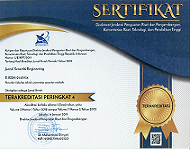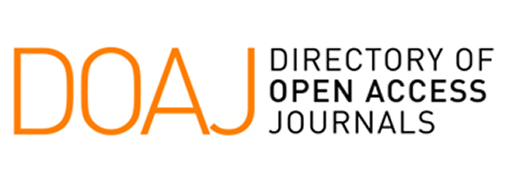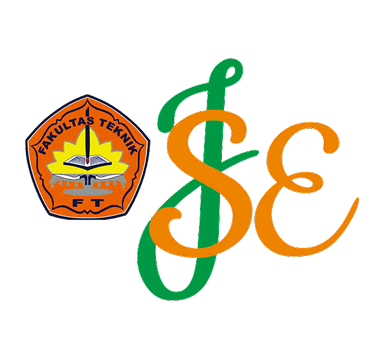Spatial and Temporal Analysis of Noise Level Distribution in Residential Areas Around Poris Station
Keywords:
noise pollution, spatial analysis, urban environment, residential noise, noise mappingAbstract
The rapid expansion of urban areas in Indonesia has led to an increase in noise pollution, especially in residential areas near transportation hubs. Poris Station is surrounded by dense settlements and exposed to train activity that may affect community well-being. This study aims to analyze the spatial and temporal distribution of noise levels around Poris Station using a Geographic Information System (GIS). Measurements were conducted at 14 points (seven points in the north, seven points in the south) from 07:00 to 21:00 WIB for two weeks. The highest noise levels were at points closest to the station (1A and 1B), with an average of 70 dBA during morning and evening rush hours, reaching 81 dBA at 07:00 AM. In contrast, more distant points like 4A, 4B, and 6A tend to be below 55 dBA, especially at night. Most southern points recorded daytime and nighttime average noise levels above the 55 dBA threshold set by Decree of the Minister of Environment No. 48 of 1996. This confirms that the distance to rail activities affects noise exposure. GIS-based noise mapping can support noise control and urban planning, including the use of vegetation or structural barriers to reduce impacts.
References
[1] H. S. Hasibuan, T. P. Soemardi, R. Koestoer, and S. Moersidik, “The Role of Transit Oriented Development in Constructing Urban Environment Sustainability, the Case of Jabodetabek, Indonesia,” Procedia Environ. Sci., vol. 20, pp. 622–631, 2014, doi: 10.1016/j.proenv.2014.03.075.
[2] H. Tong and J. Kang, “Relationship between urban development patterns and noise complaints in England,” Environ. Plan. B Urban Anal. City Sci., vol. 48, no. 6, pp. 1632–1649, 2021, doi: 10.1177/2399808320930247.
[3] Sun, Yu, and Yin Cui. "Analyzing urban infrastructure economic benefit using an integrated approach." Cities 79 (2018): 124-133.
[4] B. Srinivasu, A. Professor, and P. Srinivasa Rao, “Infrastructure Development and Economic growth: Prospects and Perspective,” J. Bus. Manag. Soc. Sci. Res., vol. 2, no. 1, pp. 2319–5614, 2013.
[5] M. Aissa Mohamed, “International Journal of Multidisciplinary and Current Research A Study of noise pollution and impact on human health,” Int. J. Multidiscip. Curr. Res., vol. 9, pp. 610–614, 2021, [Online]. Available: http://ijmcr.com
[6] W. Hemmat, A. M. Hesam, and H. Atifnigar, “Exploring Noise Pollution, Causes, Effects, and Mitigation Strategies: A Review Paper,” Eur. J. Theor. Appl. Sci., vol. 1, no. 5, pp. 995–1005, 2023, doi: 10.59324/ejtas.2023.1(5).86.
[7] Kementerian Lingkungan Hidup, “Keputusan Menteri Lingkungan Hidup No. 48 Tahun 1996 tentang Standar Tingkat Kebisingan,” vol. 26, no. 4, pp. 551–556, 1996.
[8] P. Mathias Basner, MDWolfgang Babisch, “Auditory and Non-Auditory Effects of Noise on Health,” NIH: National Institutes of Health, vol. 23, no. 1, pp. 1–7, 2014, doi: 10.1016/S0140-6736(13)61613-X.Auditory.
[9] H. J. Jariwala, H. S. Syed, M. J. Pandya, and Y. M. Gajera, “Noise pollution & human health: a review,” Conf. Noise Air Pollut. Challenges Oppor., no. August, pp. 1–3, 2017.
[10] M. Alzohbi, “A Sheffield Hallam University thesis,” Shura.Shu.Ac.Uk, p. 228, 2015, [Online]. Available: http://shura.shu.ac.uk/20029/
[11] Indrayani, S. Asfiati, M. N. Riky, and J. Rajagukguk, “Measurement and Evaluation of Sound Intensity at the Medan Railway Station Using a Sound Level Meter,” J. Phys. Conf. Ser., vol. 1428, no. 1, 2020, doi: 10.1088/1742-6596/1428/1/012063.
[12] Chandra, Hendrawan, Stevy Thioritz, and Hendry Tanoto Kalangi. "Analisis Perbandingan Tingkat Kebisingan Lalu Lintas Menggunakan Metode CORTN Dan Metode SNI 8427: 2017 (Studi Kasus: Segmen Jalan Sultan Hasanuddin Kabupaten Gowa)." Jurnal Media Teknik Sipil 2.2 (2024): 40-53.
[13] B. S. Kumar and V. Chowdary, Handbook of Vibroacoustics, Noise and Harshness, no. September. 2024. doi: 10.1007/978-981-99-4638-9.
[14] M. Rimjha, A. Trani, and S. Hotle, “Urban Air Mobility: Preliminary Noise Analysis of Commuter Operations,” AIAA Aviat. Aeronaut. Forum Expo. AIAA Aviat. Forum 2021, pp. 1–15, 2021, doi: 10.2514/6.2021-3204.
[15] S. Kallankandy and S. Deswal, “A Comprehensive Review of Noise Measurement, Standards, Assessment, Geospatial Mapping and Public Health,” Ecol. Quest., vol. 34, no. 3, pp. 109–124, 2023, doi: 10.12775/EQ.2023.035.
[16] D. Stuhne et al., “Design of a Wireless Drone Recharging Station and a Special Robot End Effector for Installation on a Power Line,” IEEE Access, vol. 10, no. August, pp. 88719–88737, 2022, doi: 10.1109/ACCESS.2022.3201351.
[17] J. Nygren et al., “Agent-specific, activity-based noise impact assessment using noise exposure cost,” Sustain. Cities Soc., vol. 103, no. October 2023, p. 105278, 2024, doi: 10.1016/j.scs.2024.105278.
Downloads
Published
Issue
Section
License
Copyright (c) 2025 Dinda Fairuz Nadhifah, Rijal Hakiki (Author)

This work is licensed under a Creative Commons Attribution 4.0 International License.












